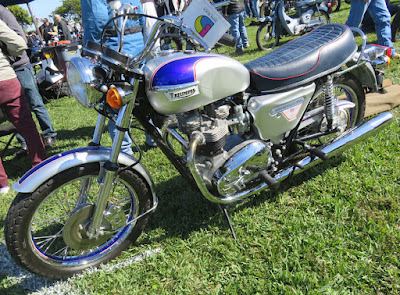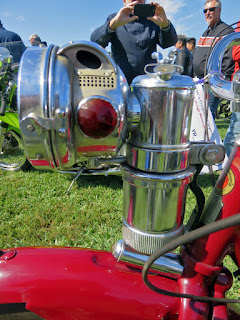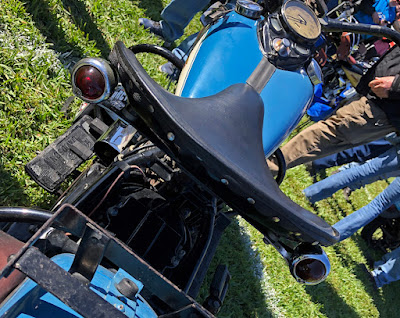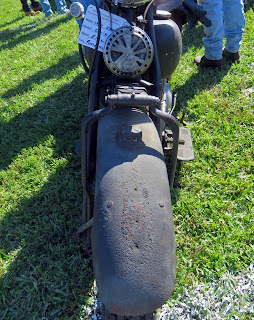 |
| 1977 Triumph Bonneville 750 Silver Jubilee Edition. |
Why do we love to look at vintage motorcycles? The Dania Beach Vintage Motorcycle Show always reminds me.
There is no one-word way to explain it, any more than the word "lust" alone explains why men love to look at women.
Watching myself looking at the motorcycles on view in Dania Beach Saturday, I saw myself drawn to the glorious form of a Vincent, the impressive function of an ancient Harley, the shiny perfection of a Gold Star BSA and the history of a military Triumph.
These are attractions I'd expect anyone to experience.
 |
| A motorcycle so self-important it dared honor a queen. Triumph Silver Jubilee Edition recognized Elizabeth's reign. |
But, then, there were the details; all those delightful details you can see on vintage motorcycles.
Let me explain: there was a time early in my life when motorcycles mystified me. I didn't know what to "look" at. They seemed to consist of two wheels, a headlight, handlebars and seat, all somehow connected by a chopped salad of mechanical parts under the tank.
In more than a decade of examining the vintage motorcycles at Dania Beach (and elsewhere) I've learned to make sense of some of the ingredients of a motorcycle.
Vintage motorcycles are best for this. Because so many of their parts are hanging out in the open, instead of hidden under plastic bodywork, they typically reveal how they work more than do modern motorcycles.
 |
| Delicate looking 1954 NSU Quickly, with lovely little tailpipe, teeny taillight and web of straps to keep skirts out of spokes. |
 |
| Vintage tire pump finds a place on 1954 NSU Quickly. |
Better yet, vintage solutions to the myriad problems and opportunities of motorcycle design were never based on invisible software. Their hardware had to solve those problems as best it could.
(I remember the day I realized that early motorcycles often solved the problem of rear suspension by just not offering any rear suspension. Was that surrender, or a case of less being more?)
 |
| Red sidelight seems whimsical on a carbide headlamp. |
A carbide headlamp didn't provide much illumination, but it was better than nothing, and the designer might show he really cared by providing a beveled side light in the lamp to mark the motorcycle at night. How thoughtful.
 |
| 1916 Indian Model K lets you see how everything worked. |
When a motorcycle was no longer new, along came the owner to add modifications, accessories or repairs that might remain on vintage motorcycles, endearing them to my eye.
There seems no limit to what a clever person can think of when they must.
 |
| Whose idea was it to put the taillights on the edges of the seat? Clever. |
I haven't even mentioned one of the greatest things that can happen to a motorcycle (in my eyes, if not my pocketbook): patina.
A vintage motorcycle that has earned its dents and rust just looks like it has stories to tell. It may not even run anymore, but it continues to power the imagination.
What could be better?
 |
| Rust, dents and patina on 1937 Indian Chief. |



























No comments:
Post a Comment